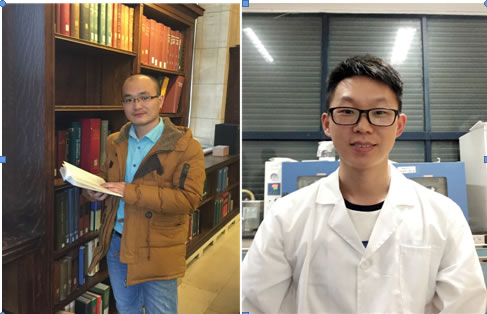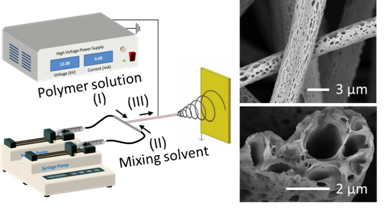Recently, important progress on the fabrication of ultrafine porous fibers has been made by a research group from the Department of Nonwoven Materials and Engineering, College of Textiles, Donghua University. This work entitled “Direct electrospinning of ultrafine fibers with interconnected macro-pores enabled by in situ mixing microfluidics” has been published by ACS Applied Materials & Interfaces(IF=7.15, DOI: 10.1021/acsami.6b11362).

Figure 1. The co-authors of Wanjun Liu (left) and Lei Zhu (right)
The controllable fabrication of heterogeneous ultrafine fibers is a crucial direction that researchers are working on. Until now, various heterogeneous fibers including porous, grooved, hollow, and multi-channel fibers have been produced. Taken grooved fiber as an example, Not only the groove texture on the fiber surface can be tuned, but also the interior structure can be tailored from solid to porous.However, it is still a vital challenge to fabricate ultrafine fibers with interconnected macro-pores (>50 nm), if overcome, the specific surface area, porosity, and surface roughness of ultrafine fibers would be greatly improved, which would contribute to improved application performance. For example, increasing the surface roughness would contribute to the improvement of cell attachment and proliferation, and render the fiber mat with superhydrophobicity. In addition, increasing the specific surface area and porosity would also be capable of enhancing the application performance on absorption, sensors, catalysis, biomedical engineering, etc.

Figure 2. The schematic diagram of in situ microfluidic electrospinning and SEM pictures of macro-porous fibers.
The co-authors of Wanjun Liu and Lei Zhu (Figure 1) have developed an in situ microfluidic electrospinning (IME) technique and achieved the controllable fabrication of ultrafine fibers with interconnected macro-pores (Figure 2). Specifically, a microfluidic nozzle has been employed which allows for the simultaneous electrospinning of solution immediately after mixing, thus overcoming the challenge of the electrospinning of unstable solutions, and facilitating the fabrication of macro-porous fibers through non-solvent induced phase separation. The diameter of the macro-porous fibers can be tuned from 1.80 ± 0.40 to 6.75 ± 0.48 μm by adjusting the solution concentration and the feeding rate of mixing solvent. The results indicated that macro-porous fibers exhibited higher specific surface area (48.66 ± 8.30 m2 g−1), larger pore size (116.73 nm) and pore volume (0.169 ± 0.007 cm3 g−1) than conventional electrospun porous fibers, enabling the high oil absorption capacities of 95.68, 57.98, and 34.82 g g−1 for silicon oil, motor oil, and peanut oil, respectively. This method has greatly expanded the solution scope for electrospinning from stable solution systems to unstable or substable solution systems, thus providing intriguing opportunities for the investigation and fabrication of heterogeneous fibers by in situ mixing of various immiscible solvents/solutions. These findings can serve as guidelines for the electrospinning of ultrafine fibers with interconnected macro-pores (>50 nm)
This work was supported by National Natural Science Foundation of China (51403033) and the Fundamental Research Funds for the Central Universities from China (No. 14D310106 and NO. 2232014D3-15). Wanjun Liu acknowledges the financial support from the program of China Scholarships Council (No. 201406630041).

